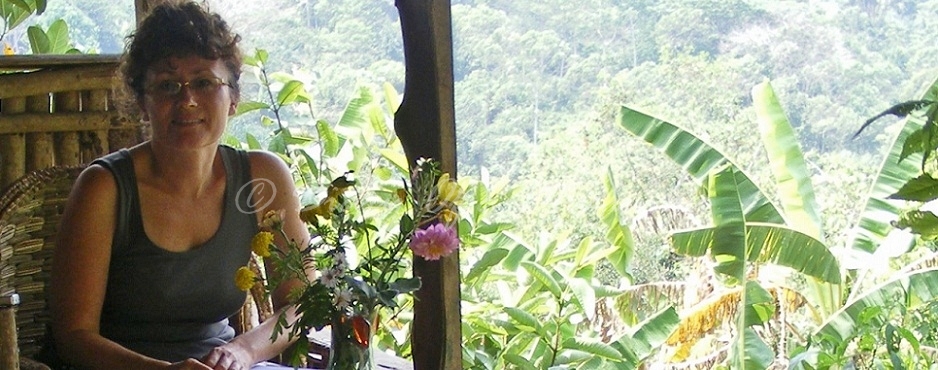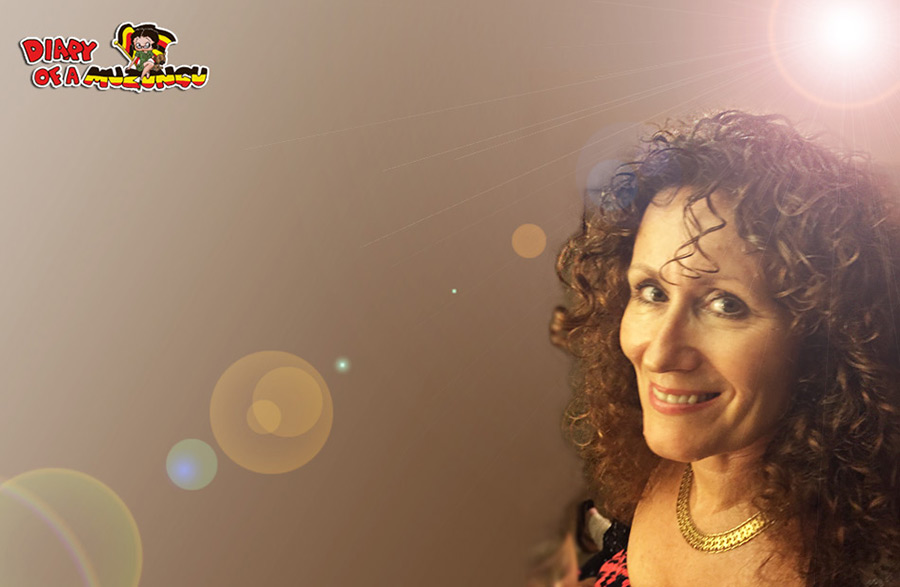
Three dogs bark excited greetings as we drive up the steep hill on the approach to Julia’s house on the edge of Kibale Forest.
The four hours from Kampala to Fort Portal on tarmac are easy. The last hour of the journey is the hardest: balancing a plastic bag full of raw eggs on my lap, as Julia races down the rutted dustbowl that passes for a road. Cool crater lakes beckon right and left.

I’m having a break from the midday sun. Julia suggests I haul my Jerry can of cold water up into the sunshine so it’s warm for my afternoon shower. Butterflies circle around the water dripping into the washing bowl beneath the Jerry can. Julia’s world is full of her dad’s home-made inventions, contraptions in which Jerry cans feature prominently.
Determined to finish her Ph.D., Julia is spending most of her time in Kampala this year. We arrive in Kibale to find the inverter is broken, so there’s no power; the solar panel isn’t working either. There’s no gas left in Fort Portal, so we borrow a gas cylinder from a local lodge. At least we won’t have to rely on the charcoal stove to cook dinner and heat water for eight people for the next three days! This weekend may be classed as a trial run for future tourism endeavours! (Fast forward a few years and Julia’s place has developed in leaps and bounds: home is now known as Sunbird Hill).
Hope has prepared dinner: it’s ‘Irish’ (potatoes) from the garden, and g’nut (groundnut) sauce. The home-grown groundnuts are stored in a gigantic Ali Baba basket. Swimming in my g’nut sauce is a Lungfish, whole. I can’t face eating it and guiltily leave the fish in the pot. The kids found it in the river when they were collecting water this morning – I guess someone will have the stomach for it.
After dinner, a slither of moon to guide us, we check out the park boundary paths. As we inch past, torchlight reveals spiderwebs suspended between branches. We duck under the washing line. The dogs bound ahead of us into the trees.
Freshly broken branches are evidence of a recent elephant visit.

“Wake up, the chimps are here! Come quick!” Yells Julia the following morning.
Bleary-eyed, I climb the viewing platform and we watch a solitary chimp warming himself in the early morning sun some 30 metres above ground. It’s my first sight of a chimpanzee in the wild.
Julia spent many years living in a treehouse deep in the forest studying Kibale Forest’s chimpanzees.
Baby Dillon points at the sweet bananas. He’s eaten four bananas by the time we arrive at the lodge on the edge of Kibale Forest. I’m covered in banana (there’s no chance of keeping clean around dogs and babies). Ornithologist and bird ringer Malcolm Wilson arrives shortly with five visitors, here to do a bird census and to advise Julia on how to maximise the biodiversity to attract more birdlife from the forest.
Before he arrives, we walk down to the forest boundary a few hundred metres away and check the ‘slashing’ (cutting back of the Bush). Four men have been working all morning to clear an access path for the nets.
We stop for a minute to debate whether to cut down a slender branch hanging over the path.
“Don’t touch that,” says Julia, “that’s the National Park.”
We look up, straight into the eyes of a Green Mamba! It’s a message: he is protecting the forest.
I’ve added four new birds to my bird list this morning; I can’t wait to add more over the next two days.
We notice freshly broken branches across our path – “The elephants must be close,” says Julia.
Next installment from Kibale Forest: a ticking off – ringing birds in Kibale Forest




























Sounds wonderful except for the you know whats strung across the path. How resourceful you are with the cooking arrangements. Atmosphere good, I was there…..
Well at least we SAW the ‘you know whats’ – just glad I didn’t walk thru the bush with my mouth open! ha ha
i really need to get in touch with the muzungu. i love your writing and would love to share it with others in our magazine. please get in touch bcoz i have failed!
Hi Pamela thanks for your message and the compliment:) You should have my reply on email? I look forward to working with you. Have a nice day!
Five years on, and so much has changed!
The majority of the road from Fort Portal is now tarmac.
Julia and (most of the) family are living back in Kanyanchu and the viewing platform has been totally transformed. Malcolm has revisited and chimping and birding tourism plans are afoot!
Can you believe that I have been living here on the edge of Kibale Forest for over a year now? I could not be happier 🙂
I’ve travelled all over East Africa but have yet to find anywhere that beats the dawn chorus here on the edge of the forest. I wake early every day – just to make sure I don’t miss a note of birdsong!
There have been so many changes here since I wrote this blog in 2012. The Fort Portal to Kamwenge Road is now one of the best in the country, making transport far easier (although we constantly worry about the wildlife that is killed by speeding cars. We have seen black and white Colobus, a Nile Monitor Lizard, snakes, sunbirds and even butterflies that have been knocked by vehicles).
Julia has launched her NGO In the Shadow of Chimpanzees, and is working with the local community to develop village tourism (a Healing Garden of medicinal plants, butterfly tourism) and conservation education (Sunday Village Bird Club) for the children.
There’s a whole lot of fun to be had here on the edge of the forest! Every day is different: there’s so much to absorb and learn here in the depths of the countryside.